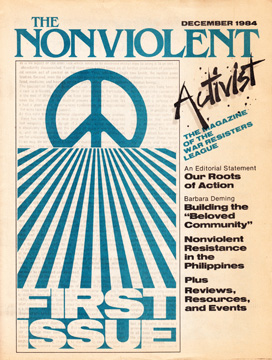My Favorite Issue: The Essence of Nonviolence: NVA’s Inaugural Editorial, 1984

In 1984, WRL hired me to be the founding editor of The Nonviolent Activist. In retrospect, the inaugural issue that appeared in December was a reflection of the state of WRL at the time — and its publication was an important moment in my own life.
“Founding editor” sounds much more significant than it actually was. In reality, I took the part-time job as a working-class kid fresh out of college. I had helped start an alternative student publication, been politically active during the Reagan-era military build-up, and had a work-study job with ISTNA (International Seminars on Training for Nonviolent Action), which had received financial support from the A.J. Muste Memorial Institute. I knew the mechanics of putting together a publication, was familiar with and supportive of WRL’s approach to nonviolent action, but had no significant track record in either.
I started at WRL with the able guidance and support of a Publications Committee made up of Rick Bickhart (our graphic designer), Ed Hedemann, David McReynolds, Matt Meyer, John M. Miller, Susan Pines, Murray Rosenblith, and Wendy Schwartz. Those names are all familiar ones to anyone who followed the evolution of WRL in the ensuing years. In working with them and the other WRL staff, I received a crash course in WRL and movement history. It was an educational experience I value to this day.
The most significant article in that first issue of the NVA was a two-page editorial statement called “Our Roots of Action,” signed by the Publications Committee. If memory serves me well, the article was loosely drafted by David McReynolds, and my job was to revise it, incorporating the many comments and suggested changes from other committee members.
Re-reading it now, years later, it strikes me as a piece written by committee. The first third of the article is devoted to acknowledging broad influences (anarchism, socialism, western liberalism, and a general utopianism) and noting the importance of the feminist critique of patriarchy and the role of environ- mentalism. That’s a lot of terrain to traverse in a few hundred words and it threatens to be a laundry list. (Yet, notably, the all-white committee makes no mention of anti-racism work in this part of the piece.)
The article’s strongest part, by far, is its middle third, where two connected themes are developed. First, the idea that “the link between means and ends has served as the thread connecting all nonviolence thinking” is introduced. This anal- ysis condemns the tragedies of totalitarianism, where means inconsistent with stated ends paved the road to slave camps and mass executions. It also condemns a variety of American efforts where, despite sometimes good intentions, the arrogant use of violence undermined the ability to achieve worthwhile goals, declaring, “The United States has all too often brought destruction to others through our inability to limit ourselves.”
This segues to the related theme of acknowledging limits. Here, there is a pervasive sense of humility that remains appealing, as in, “Those of us working on this magazine have barely enough wisdom to run our own lives. Often not enough.” Such statements were not just personal acknowledgments; they were building blocks of a political analysis. The editorial illustrates this with, “We cannot possibly profess to know what is the ‘correct’ line of action for people living in El Salvador, in Nicaragua, in Poland, in South Africa, in Afghanistan, or in other situations.” And finally, “We are imperfect in a world that is imperfect. We cannot claim to know truth. Yet, this lack of absolute knowledge must not prevent us from acting on our beliefs. We use nonviolence both because of our commitment to action and because of our recognition of our limits.”
To me, that remains the essence of a nonviolence philosophy. In an age where the hubris of drone assassi- nations and the fanaticism of religious violence dominate the headlines, emphasizing the importance of a little humility seems more vital than ever.
The final third of the article sadly foreshadows some of the problems that would prompt me to leave the NVA just a few years later. The editorial statement is forced to ac- knowledge that “we have many divisions within our own ranks.” It seems comfortable with marginality, not only in society but even within already marginal movements by noting, “We are the left, yet we are a problem for the left.” Even the first letter published in the NVA was from readers who were “dismayed, discomfited, and amazed” by earlier WRL News articles implicitly supporting voting for a Democratic presidential candidate.
Such a focus on somewhat esoteric debates—while the world outside went on without noticing—became disillusioning for my younger self. More important, I think it was part of why I doubt the NVA had a significant impact while I was there, either within WRL or, certainly, the broader progressive community. It was largely an inward-looking publication that rarely reached out beyond a small choir.
But even choirs must be sustained and I hope that some readers of the NVA learned from it and felt supported by its message. My own siren called me back to more mainstream work. I felt more useful promoting a basic message about social change and the potential power of nonviolence to more diverse audiences. However, the lessons I learned in working on the NVA—the lessons articulated in the best parts of the inaugural issue’s editorial statement—stayed with me. I hope I am not alone.
Today, unlike in the era of paper periodicals, digital plat- forms dangle the possibility of WRL having unprecedented reach, looking outward to engage with a broader audience about the relevance of nonviolence. While doing so effec- tively will require creativity and experimentation, it is an opportunity I hope the next generation of WRLers takes up enthusiastically.
